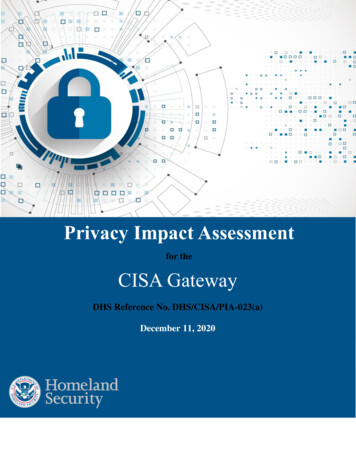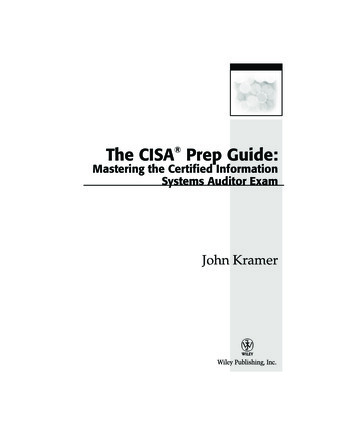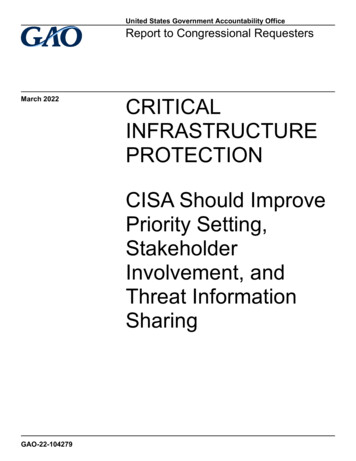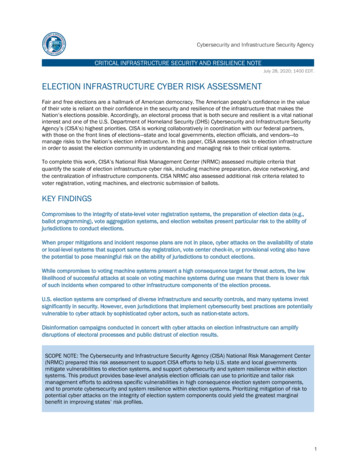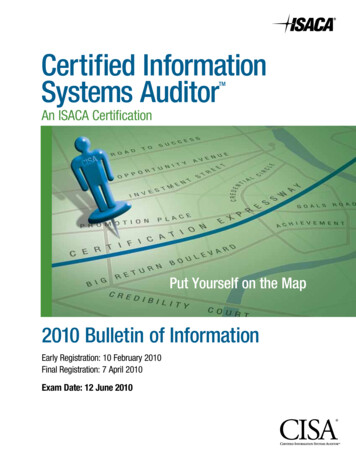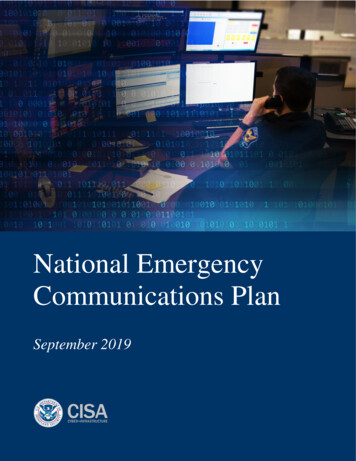
Transcription
National EmergencyCommunications PlanSeptember 2019
This page intentionally left blank.
Message from the DirectorThe Department of Homeland Security’s (DHS) commitment to ensuring ahomeland that is safe, secure, and resilient against evolving threats andhazards is what has guided our work since its establishment in 2002.Ensuring operable and interoperable communications and real-timeinformation sharing among responders during all threats and hazards isparamount to the safety and security of Americans. From a small-scaleincident to a significant natural or manmade disaster, responders depend onthe seamless flow of voice, video, and data communications to respond to and recover fromevents that threaten lives and property.The National Emergency Communications Plan (NECP) is the Nation’s roadmap to ensuringemergency communications interoperability at all levels of government. The Cybersecurity andInfrastructure Security Agency leads the effort to update and implement the NECP, but itrequires participation from the whole community to be successful. Since the last NECP release in2014, the emergency communications landscape has experienced unprecedented change. Thefrequency and complexity of emergencies are on the rise during a time when technology isadvancing at a faster pace than any other time in history. While responders still rely heavily onland mobile radio for voice communications, comprehensive strategies for emergencycommunications must integrate the full Emergency Communications Ecosystem, includingbroadband, alerts and warnings, social media, and Next Generation 911.Internet Protocol-based devices and applications have the potential to vastly improve emergencyresponder capabilities, yet also introduce new challenges such as cybersecurity threats, the needfor a more technically skilled workforce, and shorter equipment lifecycles. The NECPemphasizes the need for strong governance structures, updated policies and procedures, as wellas joint exercises and trainings to improve interoperability which ensures information is providedto the right people at the right time.The 2019 NECP update was developed in partnership with Federal, state, local, tribal, andterritorial jurisdictions and the private sector. We must work together to address the complexmission and achieve the NECP’s stated vision to:Enable the Nation’s emergency response community to communicate and shareinformation securely across communications technologies in real-time, including alllevels of government, jurisdictions, disciplines, organizations, and citizens impacted byany threats or hazards event.To that end, I thank those who contributed to the development of this Plan and ask for yourcontinued cooperation and assistance as we implement the NECP. By working together will wemake progress toward increasing the effectiveness and efficiency of emergency communicationsand information sharing and ultimately help protect the lives of our fellow Americans.Christopher C. KrebsDirector, Cybersecurity and Infrastructure Security Agency
Table of ContentsExecutive Summary . ES-1Introduction . 1Emergency Communications Ecosystem . 6NECP Strategic Goals . 10Goal 1: Governance and Leadership . 11Goal 2: Planning and Procedures. 17Goal 3: Training, Exercises, and Evaluation . 21Goal 4: Communications Coordination . 26Goal 5: Technology and Infrastructure . 32Goal 6: Cybersecurity . 37Implementing the NECP . 41Conclusion. 43Annex: Success Indicator Descriptions. AN-1Appendix 1: Requirements Matrix . A1-1Appendix 2: Roles and Responsibilities . A2-1Appendix 3: SAFECOM Interoperability Continuum . A3-1Appendix 4: Source Documents and References . A4-1Appendix 5: Glossary. A5-1Appendix 6: Acronyms . A6-1Appendix 7: NECP Endorsement Letter . A7-1
Executive SummaryEvery day in cities and towns across the Nation, emergency response personnel respond to incidentsof varying scope and magnitude. Their ability to communicate in real time is critical to establishingcommand and control at the scene of an emergency, maintaining event situational awareness, andoperating within a broad range of incidents. However, as numerous after-action reports and nationalassessments have revealed, there are still communications deficiencies that affect the ability ofresponders to manage routine incidents and support responses to natural disasters, acts of terrorism,and other incidents.Recognizing the need for an overarching emergency communications strategy to address theseshortfalls, Congress directed the Department of Homeland Security (DHS) Office of EmergencyCommunications—re-designated in 2018 as the Emergency Communications Division within theCybersecurity and Infrastructure Security Agency (CISA)—to develop and periodically update theNational Emergency Communications Plan (NECP). Title XVIII of the Homeland Security Act of2002 (6 United States Code 101 et seq.), as amended, calls for DHS to develop the NECP incoordination with stakeholders from all levels of government and the private sector. DHS previouslyupdated the plan in 2014. This publication is the second update.DHS worked with stakeholders from federal, state, local, tribal, and territorial agencies, public safetyassociations, and the private sector to develop the NECP—a strategic plan that establishes a nationalvision for the future state of emergency communications:To enable the Nation’s emergency response community to communicate and shareinformation securely across communications technologies in real time, including alllevels of government, jurisdictions, disciplines, organizations, and citizens impacted byany threats or hazards eventThe NECP establishes six strategic goals to drive progress toward the vision:Goal 1: Governance and LeadershipDevelop and maintain effective emergency communications governance and leadership across theEmergency Communications EcosystemGoal 2: Planning and ProceduresDevelop and update comprehensive emergency communications plans and procedures that address theevolution of risks, capabilities, and technologies across the Emergency Communications EcosystemGoal 3: Training, Exercises, and EvaluationDevelop and deliver training, exercise, and evaluation programs that enhance knowledge and targetgaps in all available emergency communications technologiesGoal 4: Communications CoordinationImprove effective coordination of available operable and interoperable public safety communicationscapabilities for incidents and planned eventsGoal 5: Technology and InfrastructureImprove lifecycle management of the systems and equipment that enable emergency responders andpublic safety officials to share information efficiently and securelyGoal 6: CybersecurityStrengthen the cybersecurity posture of the Emergency Communications EcosystemES-1 Executive Summary
To meet these goals, the updated NECP establishes 19 objectives, each with success indicators, for thecontinued improvement of emergency communications for the Nation. Public safety agencies andpartners should incorporate elements of these objectives into their federal, state, tribal, territorial,regional, jurisdictional, and local-level plans and measure progress until the associated successindicators have been achieved. By adopting these goals and objectives into their strategic plans,agencies support three national priorities for advancing emergency communications:Enhance effective governance across partners with a stake in emergencycommunications, embracing a shared responsibility of the whole community fromtraditional emergency responders and supporting entities to the citizens served ;2. Address interoperability challenges posed by rapid technology advancements andincreased information sharing, ensuring the most critical information gets to the rightpeople at the right time; and3. Build resilient and secure emergency communications systems to reduce cybersecuritythreats and vulnerabilities.1.Communications investments are among the most significant, substantial, and long-lasting capitalexpenditures that public safety agencies make. Stakeholders must balance financial challenges tokeep pace with the rapid technological advancements in an era of reduced grant funding andconstrained resources. Additionally, the whole community faces increasingly complex incidents andthreat environment. Communication support must include the integration and alignment oftechnologies (e.g., land mobile radio, Next Generation 911, First Responder Network Authority’sNationwide Public Safety Broadband Network, as well as alerts, warnings, and notifications systems)and standard processes to support the interoperability of systems and services for informationexchange among the responder and partner communities. With these realities in mind, CISArecognizes that the emergency response community will realize this national vision in stages, asagencies invest in new communications systems and technologies emerge.The NECP provides guidance to those that plan for, coordinate, maintain, invest in, and usecommunications to support public safety operations. Given the diverse entities that are directlyinvolved, supporting, or impacted by emergencies, the Emergency Communications Ecosystemincludes the various functions and people that exchange information prior to, during, and afterincidents and planned events. This includes traditional emergency responder disciplines (e.g., lawenforcement, fire, emergency medical services, emergency communication centers/public safetyanswering points, emergency management) and other entities that share information duringemergencies, such as medical facilities, utilities, nongovernmental organizations, as well as the mediaand private citizens. The Ecosystem is dynamic, depending on the incident or planned event, as wellas multi-directional because anyone can initiate emergency communications. Although the individualresponsible for coordinating emergency communications varies across jurisdictions, regions, andorganizations, having an established central point of contact is critical for progressing emergencycommunications capabilities. Since the first NECP, states and territories have made strides inappointing a Statewide Interoperability Coordinator to serve as a central coordinator foremergency communications; however, not all have dedicated resources to this critical full-timeposition.To implement the updated NECP, CISA will partner with the public safety community to identifystrategies to accomplish the NECP’s goals and objectives to improve nationwide emergencycommunications capabilities. CISA acknowledges that the Nation does not have unlimited resourcesExecutive Summary ES-2
to address all deficiencies in emergency communications. Consequently, the NECP will be used toidentify and prioritize investments to move the Nation toward this common vision.The future of emergency communications is at a critical juncture. Through the NECP and the work ofCISA and its partners, CISA is committed to supporting the Nation’s emergency responders, includingsupporting organizations, decision makers, and citizens, as they strive to meet their missions andadvance emergency communications. As required by Congress, the NECP is a living documentsubject to periodic review and updates by CISA in coordination with stakeholders. Future iterationswill be revised based on progress made toward achieving the NECP’s goals, variations in nationalpriorities, and lessons learned from after-action reports.ES-3 Executive Summary
NECP VISION .To enable the Nation’s emergency response community tocommunicate and share information securely across communicationstechnologies in real time, including all levels of government,jurisdictions, disciplines, organizations, and citizens impacted by anythreats or hazards event.Executive Summary ES-4
IntroductionEmergency communications are critical to the Nation’s ability to respond todevastating natural disasters, terrorist threats, and other emergency events,incidents, and routine activities affecting our communities every day. Whenfaced with these situations, the public safety community has a collectiveresponsibility to share information. Achieving this goal requirescommunications capabilities that are resilient and secure 1 today, yet agileenough to integrate advanced and emerging technologies tomorrow. Thisimportant component of national preparedness relies on coordinated inputfrom the whole community, including individuals, the private sector, nonprofits, and all levels of government (e.g., federal, state, tribal, territorial,regional, jurisdictional, and local).Since the establishment of Department of HomelandSecurity (DHS) in 2003, one of its top priorities hasEmergency Communicationsbeen to improve communications capabilities among theThe means and methods for exchanging informationpublic safety community. The Department has partnerednecessary for successful incident managementwith emergency responder agencies to ensure access toreliable, secure, and interoperable communications at alltimes in order to save lives, protect property, safeguard the environment, stabilize communities, andmeet basic human needs following an incident.The Homeland Security Act of 2002 (6 U.S. C. § 1802) as amended, provided renewed focus andvitality to this critical homeland security mission. The legislation established the DHS Office ofEmergency Communications, which was re-designated as the Emergency Communications Divisionwithin the Cybersecurity and Infrastructure Security Agency (CISA), to lead the development andimplementation of a comprehensive approach to advancing national interoperable communicationscapabilities. To achieve this objective, the act required CISA to develop the National EmergencyCommunications Plan (NECP) to “provide recommendations regarding how the United States shouldsupport and promote the ability of emergency response providers and relevant government officials tocontinue to communicate in the event of disasters and to ensure, accelerate, and attain interoperableemergency communications nationwide.”2 Appendix 1 details how the NECP meets the statutoryrequirements.3CISA collaborates closely with the public safety community to support and promote effectiveemergency communications through stakeholder-driven programs and services. Over the next 5 years,CISA will focus its efforts on implementing the goals and objectives articulated in the NECP. Thesecritical components for advancing emergency communications fall under three national priorities: (1)to enhance effective governance across partners with a stake in emergency communications,1For purposes of this document, secure refers to the confidence in confidentiality, integrity, and availabilityof communications, not to government sensitive or classified communications.2Homeland Security Act of 2002 (6 U.S. C.§ 1802), as amended.3Appendix 2 lists the NECP’s key authorities.1 Introduction
embracing a shared responsibility of the whole community from traditional emergency responders andsupporting entities to the citizens served; (2) to address interoperability challenges posed by rapidtechnology advancements and increased information sharing, ensuring the most critical informationgets to the right people at the right time; and (3) to build resilient and secure emergencycommunications systems to reduce cybersecurity threats and vulnerabilities, as introduced throughInternet Protocol (IP)-based technologies and services.PurposeAs the Nation’s strategic plan for emergency communications, the NECP establishes a vision toenable the Nation’s emergency response community to communicate and share informationsecurely across communications technologies in real time, including all levels of government,jurisdictions, disciplines, organizations, and citizens impacted by any threats or hazards event . Toachieve this vision, the NECP outlines 6 nationwide goals and 19 objectives to improve criticalcapabilities through partnerships, joint planning, and unified investments across levels of government.Its focus is to ensure the public safety community and citizens are collectively driving toward acommon end-state for communications.DevelopmentTo envision a desired future state, CISA examinedcurrent strategies, resource decisions, and investmentsfor emergency communications and impacts from anever-evolving environment. Through ongoingcoordination with emergency responders, CISAreviewed the whole community’s manyaccomplishments since the first NECP’s publication inorder to understand the remaining hurdles to be cleared.4“The SAFECOM NationwideSurvey gives us a clearpicture of where we are—asopposed to where we thinkwe are—and identifies whatto address to get where we”CISA conducted the SAFECOM Nationwide Surveywant to be.and resulting 2018 Nationwide CommunicationsBaseline Assessment, in which thousands of publicSheriff Paul Fitzgeraldsafety agencies and organizations participated.Story County Iowa, SAFECOM MemberAdditionally, CISA used an extensive stakeholderengagement process to identify challenges and proposesolutions to help improve emergency communications. As a result, representatives of major publicsafety organizations, government agencies, and key industry partners from the communications andinformation technology sectors recommended updating the NECP’s vision, goals, and objectives toreflect current capability gaps and needed improvements.4Information about the SAFECOM Nationwide Survey and results can be found at https://www.cisa.gov/safecom/sns.Introduction 2
ScopeThe NECP serves as the Nation’s strategic plan to improveemergency communications. It provides guidance to those thatplan for, coordinate, invest in, and use communications to supportresponse and recovery operations. This includes traditionalemergency responder disciplines (e.g., law enforcement, fire,emergency medical services, emergency communication centers/public safety answering points, and emergency management) andother partners that exchange information prior to, during, andafter incidents and planned events.ProgressIn the 2018 Nationwide Communications Baseline Assessment,respondents across the targeted disciplines and levels ofgovernment indicated there was an overall strengthening ofemergency communications since 2011. For example, more than84 percent of state and territorial respondents reported significantor some improvement in the strengthening of theircommunications operability, interoperability, or continuity. Whilethese results show progress, findings also reflected the need toaddress specific challenges, including emerging technologies(e.g., IP-based networks, next-generation data technologies); newcapabilities (e.g., mobile data, public safety applications); andnew partners (e.g., information technology departments, privatesector infrastructure owners).CISA has helped the public safety community implement theNECP through its programs, services, and guidance. CISAprovides on-site technical assistance, training, and regionalsupport at no cost to agencies, including instruction on theplanning, governance, operational, and technical aspects ofdeveloping and implementing emergency communications.3 Introduction
Organization of the NECPThis update to the NECP supersedes the 2014 NECP update and is effective immediately. The plan iscomprised of the following four sections: Emergency Communications Ecosystem explains the various people and functions thatexchange information prior to, during, and after incidents and planned events. NECP Strategic Goals and associated objectives, establishes the strategy to meet the threenational priorities and better position the whole community for the future of emergencycommunications. Figure 1 depicts a summary of the NECP’s vision, goals, and objectives. Implementing the NECP describes CISA initiatives to develop an action plan and promotioncampaign, measure progress through nationwide communications assessments, and reportbiennially to Congress. Conclusion recaps the plan’s themes and key take-aways for emergency communicationsofficials.The included Annex expands upon the descriptions of the success indicators for the NECP goalsand objectives. Appendices include the Statutory Requirements Matrix, Key Authorities, Rolesand Responsibilities, the SAFECOM Interoperability Continuum, Source Documents, Glossary,and Acronyms.Introduction 4
Figure 1: Summary of NECP Goals and Associated Objectives5 Introduction
Emergency Communications EcosystemSince the NECP was first published in 2008, the public safety communityhas made significant strides to enhance governance structures, adoptcommon policies and procedures, expand training and exercise programs,migrate legacy systems, integrate new technologies, and mitigate thegrowing number of cyber threats. These efforts are not constrained withinthe limits of traditional emergency response of law enforcement, fire,emergency medical services, and emergency communication centers/publicsafety answering points. Instead, entities with different communicationsfunctions including supporting organizations, decision makers, and citizensrely on one another to exchange information prior to, during, and afterincidents and planned events—a concept referred to as the EmergencyCommunications Ecosystem.The public safety community continues to prioritize maintaining land mobile radio and data exchangesystems, as well as improving operability, interoperability, and resiliency of communicationscapabilities. Emergency responders are also embracing emerging technologies and integrating themwith existing systems. With the First Responder Network Authority’s (FirstNet Authority)implementation of the Nationwide Public Safety Broadband Network, agencies will be able tosupplement existing systems to provide public safety users with dedicated spectrum, added broadbandcapabilities, and advanced technologies to increase situational awareness. However, networkintegration presents new cybersecurity risks as a result of interconnected, IP-based technologies. Itrequires implementing effective strategies to enhance the resiliency of IP-based infrastructures andsafeguard private or sensitive information transmitted across systems and devices, while also enablingresponse.Response agencies are becoming more connected to additional sources of information duringemergencies, such as medical personnel, critical infrastructure operators, and private citizens. Whilethese individuals are not typically trained responders, they can share valuable information duringresponse and recovery efforts. Additionally, because social media use is increasing, responders needto (1) develop best practices for engaging with the public to ensure accessibility to and for allcitizens,5 and (2) analyze social media to gain situational awareness in times of civil unrest,emergencies, and disasters. Agencies also face challenges retaining qualified communicationspersonnel, securing adequate funding for ongoing operations and maintenance, and navigatingcomplex and varying governance structures to formalize partnerships and establish resource sharingagreements.5Considerations for responders and private citizens include disabilities and others with access and functional needs.Ecosystem 6
To organize the whole community toward the NationalPreparedness Goal, the National Response FrameworkNational Preparedness Goaland National Incident Management System guide howA secure and resilient Nation with the capabilitiespublic safety responds to all types of emergencies.required across the whole community to prevent,These guiding principles are built on scalable, flexible,protect against, mitigate, respond to, and recoverand adaptable concepts for managing incidents thatfrom the threats and hazards that pose therange from the serious but purely local to large-scalegreatest riskterrorist attacks or catastrophic natural disasters. Theydefine roles, responsibilities, and coordinatingstructures for delivering core capabilities required to respond to an incident and how response effortsintegrate with other preparedness mission areas, including prevention, protection, mitigation, andrecovery.Incorporating the National ResponseFramework and National Incident ManagementThe Emergency CommunicationsSystem principles, the EmergencyEcosystem must support theCommunications Ecosystem is comprised ofcommunity’s incident response role tothe various functions and people that exchangemake our Nation safer and more resilientinformation prior to, during, and after incidents.The Ecosystem includes the breadth ofas we face increasingly complexorganizations and individuals with roles inemergencies. The NECP prepares publicemergency communications, beyond traditionalsafety to address today’s challengesemergency responder disciplines, government6agencies, and jurisdictional boundaries. Theand plan for the future.Ecosystem is dynamic; not everyone is neededevery day, depending on the incident orRon Hewittplanned event. Being multi-directional,Assistant Director for Emergency Communications, CISAemergency communications can be initiated byanyone, including supporting entities or private citizens. The hypothetical scenario in Figure 2illustrates response complexities (e.g., use of social media and citizen engagement) that are becomingmore commonplace as the Emergency Communications Ecosystem evolves.6Appendix 3: Roles and Responsibilities describes whole community partners, public and private, that are involved in theemergency communications mission.7 Ecosystem
Figure 2: Emergency Communications Ecosystem in ActionEcosystem 8
As illustrated in the scenario, communications functions within the Emergency CommunicationsEcosystem have become increasingly interwoven and complex. Figure 3 depicts key functions that arenecessary to achieve reliable, secure, and interoperable emergency communications. This includesreporting and requests for assistance; incident coordination and response; alerts, warnings, andnotifications; and public interaction.The four communications functions in Figure 3 are represented as outer blades circling wholecommunity partners. These partners represented in grey icons depict that anyone can initiate anyfunction at any time, and how information flows multiple directions, depending on the nature of theevent or incident. These primary functions, their purpose, and examples of each are listed below.Figure 3: Emergency Communications Ecosystem Key Communications Functions9 Ecosystem
NECP Strategic GoalsNECP Strategic GoalsGoal 1:Governance and LeadershipGoal 2:Planning and ProceduresGoal 3:Training, Exercises, and EvaluationGoal 4:Communications CoordinationGoal 5:Technology and InfrastructureGoal 6:CybersecurityGovernance and Leadership 10
Goal 1: Governance and LeadershipDevelop and maintain effective emergency communicationsgovernance and leadership across the EmergencyCommunications EcosystemObjective 1.1: Formalize governance through policy, documentation, andadequate fundingObjective 1.2: Structure more inclusive governance by expanding membershipcompositionObjective 1.3: Adopt adaptive governance strategies to address the rapidevolution of technologies, capabilities, and risks11 Governance and Leadership
Goal 1: Governance and LeadershipEffective coordination and decision making are critical first steps to ensuring successful emergencycommunications. Achieving this requires robust governance structures and processes designed toensure accountability, inclusiveness, adaptability, and action. The strength of emergencycommunications governance is not measured by its ability to maintain the status quo, but to driveimprovements in balance with the rapid evolution of technologies.Public safety continues to expand its network of partners to include those involved in receiving andsharing information during both normal and emergency operations. Partnership coordination is furtherstrengthened and verified by establishing formal decision-making bodies, gaining fiscal and legislativesupport from elected and appointed officials, creating consistent policy, and addressing regulatorychange. Governance bodies benefit from the contributions of representatives from all organizationswith a role in these operations, including those outside the realm of traditional response (e.g.,transportation, public works, public health, utilities, natural resources or parks and recreation, andbuilding inspectors). With the adoption and integration of new technologies, governance is an initialstep toward preparing first responders to manage the benefits and risk of increased informationexchange across
The National Emergency Communications Plan (NECP) is the Nation's roadmap to ensuring emergency communications interoperability at all levels of government. The Cybersecurity and Infrastructure Security Agency leads the effort to update and implement the NECP, but it requires participation from the whole community to be successful.





